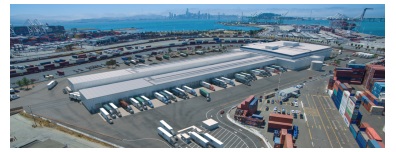Reefer Trade: Oakland, Virginia
![]() Print this Article | Send to Colleague
Print this Article | Send to Colleague
A refrigerated gateway to Asia for U.S. meat exports cleared its last big hurdle late last month when the Oakland Port Commission approved an $11 million rail spur to Cool Port Oakland.
The spur will connect Union Pacific Railroad tracks with Cool Port, a 280,000-square-foot distribution center now under construction on 25 acres of port property. Burlington Northern Santa Fe Railroad would also have rail access.
The port estimates 27,000 20-foot containers of meat could be exported annually from Oakland annually to Asia.
"The concept is to bring vast quantities of chilled or frozen beef and pork to Oakland via the rails," explained John Driscoll, the port’s maritime director. "At Cool Port, the product would be transferred in a temperature-controlled setting from rail cars to shipping containers, then whisked across the street to outbound vessels."
Lineage Logistics and Dreisbach Enterprises are building Cool Port under a lease agreement with the port. The port has agreed to oversee and cost-share construction of the 2-mile-long rail spur. A $5 million grant will offset part of the cost. Union Pacific will construct a portion of the spur on its property.
Oakland is already a leading U.S. gateway to Asia for agricultural products including meat. Port officials say Cool Port could increase shipments of beef and pork from the Midwest to as much as 27,000 TEUs annually. Proximity to the docks means will expedite cargo transfer from rail to ship.
Cool Port Oakland is expected to open in the third quarter of 2018.

Rendering of the future Cool Port Oakland complex
Source/Port of Oakland
The Port of Virginia® is the latest participant in a U.S. Department of Agriculture program designed to facilitate the import of South American fruit via U.S. East Coast ports.
The Southeast In-Transit Cold Treatment Pilot program allows entry of in-transit, cold-treated containers of blueberries, citrus, and grapes from Peru, blueberries and grapes from Uruguay, and, apples, blueberries and pears from Argentina.
"This designation is important for logistics and supply chain managers importing agricultural products because it means shorter total transit times from origin to market," said John F. Reinhart, CEO and executive director of the Virginia Port Authority. "This helps to diversify our cargo mix. It opens the door for new cargo and provides an important service for owners and shippers of perishables."
Mr. Reinhart predicts shippers will see lower transportation costs and a longer shelf-life for their products; consumers will see lower prices at the store; and there will be environmental benefits from reduced emissions related transportation.
The USDA Southeast In-transit Cold Treatment Pilot enables a limited number of containerized cargoes to enter the port directly after completing a two-week cold treatment process as a safeguard against fruit flies and other pests, as well as acquiring all the required unloading clearances prior to the shipment’s arrival in port.
Containers that fail cold treatment will be prohibited from entering the port and will not be offloaded from vessels. Instead, failed containers will be allowed transit to a Northeastern port for retreatment or returned to the country of origin.

